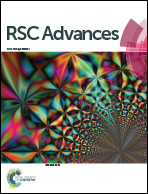Resveratrol–ZnO nanohybrid enhanced anti-cancerous effect in ovarian cancer cells through ROS
Abstract
The use of nanotechnology in medicine and more specifically in drug delivery is expected to spread rapidly. Currently many substances are under investigation for drug delivery and more specifically for cancer therapy. Nano-conjugation of the drug is likely to provide protection against degradation, increasing bioavailability, and improvement in intracellular penetration, enhanced efficacy and control delivery of the drug. In this study, ZnO nanoparticles (NPs) conjugated with a well-known anti-proliferative and chemopreventive trans-resveratrol (RSV) has been designed, characterized and found to be a potential drug for ovarian cancer treatment. Nano-conjugate (RSV–ZnO) has been characterized by FTIR, Raman scattering and Transmission electron microscopy (TEM). Picosecond-resolved fluorescence studies of RSV–ZnO nano-conjugate reveal efficient electron migration from ZnO NPs to RSV, eventually enhancing the ROS activity compared to free RSV. Various in vivo and in vitro studies including MTT assay and apoptosis studies on ovarian cancer (PA1) cell lines reveals the RSV–ZnO nano-conjugate to be more effective in cancer cell death in comparison to free RSV. DCFH assay (in vitro) and DCFDA method (in vivo in PA1 cell lines) demonstrate the huge enhancement of antioxidant property (through ROS) in case of nano-conjugate. JC-1 staining method unravels the increase in depolarization of the mitochondrial membrane in the PA1 cell upon nano-conjugate, consistent with mitochondrial dysfunction. Finally we have performed a Western blot study by expression of some proteins like actin, Bax, Bcl-2 and Caspase-9 to confirm apoptosis.


 Please wait while we load your content...
Please wait while we load your content...